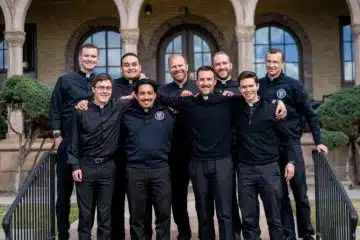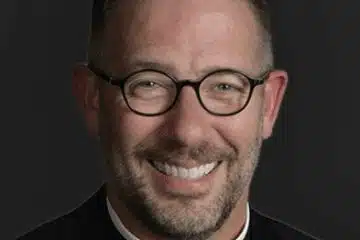Early planning can ease the transition to senior living communities
Friday, August 6, 2010
By David Eck
ARCHDIOCESE — In 2001 Donna Long and her two siblings realized that their 78-year-old mother, Ruth Graf, needed to move from her southeastern Indiana home, where she lived alone, into a senior living community.
Graf was forgetting to take her medication or turn on her oxygen and sometimes became confused; she went to a nearby grocery store, but couldn’t remember the way home. Her doctor suspected she was having mini-strokes.
 |
| Little Sister of the Poor Maria Goretti Miller assists resident Annetta Anderson at St. Paul’s Archbishop Leibold Home in Cincinnati. (Courtesy photo) |
“She knew she wasn’t safe at home,” Long said. “She trusts us, and if we say something, she believes it.”
Graf agreed with her children’s concerns about her safety, and Long began researching senior living communities, seeking one that seemed a good fit. She knew she wanted her mother to be close to at least one of her children. She studied the activities at the different communities, the staff, the resident-to-staff ratio and the overall appearance of the facilities.
“I went and looked at a lot of places,” she said, and Long moved her mother into different communities as Graf’s health worsened.
Now 87, Graf has lived at St. Paul’s Archbishop Leibold Home in Cincinnati for the last three years. A Catholic, Graf is able to attend Mass at the home operated by the Little Sisters of the Poor.
The majority of residents at Archbishop Leibold Home are in their 80s. The home offers assisted living — where residents live independently but have assistance available — and skilled nursing care for those with advanced health issues.
One of the more complex and emotional issues a family will face is encouraging an aging family member, usually a parent, to transition into a senior living community. There are always significant questions, ranging from necessity to family tension to the wants of the parent.
A key to successfully overcoming the concerns is to plan early, say representatives of senior living communities and social workers. Bringing the topic up well ahead of the time enables families to investigate the various options for senior living, clarify a loved one’s wishes and allow time to adjust to an eventual alternative living arrangement.
“Having conversations about wishes for senior living care should really coincide with planning out your advanced directives,” said Kelly Martin, director of marketing at Mercy Health Partners, which operates several senior living communities in the Archdiocese of Cincinnati. “When you’re sitting down and you’re thinking about things like your living will or thinking about your will — those are sort of life-planning decisions — and senior living really should be a part of that.”
It’s also important for families to maintain communication with the person’s primary care physician, who can trigger a discussion about senior living care. The physician’s understanding of a patient’s medical history can help assess if a person should consider assisted living or nursing care.
Among the ways to approach the subject is with a simple straightforward talk. Family members who begin to see an aging family member struggling with living alone might simply bring up the topic.
“You don’t have to go on and on,” said Carmelite Sister Norah Michael McNamara, administrator of St. Margaret Hall, a senior living community in Cincinnati. “Place the seed, and then every so often bring it up again. You really have to start early, and you have to be positive when you do it.”
Convincing an aging parent to move into a senior community can preserve their independence, socialization can be strengthened and there are more options for transportation and activity. Living alone can lead to an avoidable accident or other issue that would necessitate a move into skilled nursing care.
“You want to impress upon your parents that the whole goal is for them to remain independent as long as possible and, if a parent waits until they have a crisis occur, that goal could be compromised,” said Judy Marx, a social worker and admissions counselor at Bayley Place, a continuing care community in Cincinnati operated by the Sisters of Charity. “This is a gift parents can give their children when they agree to try something like this.”
“You find that once the seed is planted a lot of the angst is taken away,” said Doris Jones, director of marketing and business development at St. Leonard Franciscan Living Community in Centerville. “It’s the fear of the unknown.”
 |
| Teresa Hay, activities assistant at St. Paul’s Archbishop Leibold Home, and resident Henrietta Bankowski play Wii games. (Courtesy photo) |
It’s important to focus on the parents’ wants and needs, not on those of the children. Starting the process early while parents are healthy and lucid allows them to be fully involved in the discussions and make the decisions themselves.
“Make sure your wishes are known,” Martin said. “There’s nothing worse than a family having to make a decision for someone who may have dementia or Alzheimer’s, and the family is wondering what mom and dad would have wanted.”
“[Families] need to look out for themselves, too,” she added. “There’s a lot of guilt associated with making these decisions and, again, the more you communicate with your loved one, it’s only going to be the better situation for the loved one and the family.”
Sometimes the death of a spouse can trigger a discussion about senior living. This is especially true if one spouse was a caregiver to the other.
“You almost have to feel your way with it because everybody has different ideas and different feelings about their own independence, their own ability to manage and their perceived notion of what it’s like to go somewhere,” said Jane Smith, a social worker at St. Paul’s Archbishop Leibold home. “Usually after people are here they like it. If they decide not to come it’s because they’re just not ready to make that move. It feels final.”
The ideal situation is one in which parents realize health is declining and they need help, but they don’t want to be a burden to their families. They decide on their own to move into a senior community or readily agree to the suggestion. That was the case with Long and her mother.
“She was totally accepting, totally. There was no trying to convince mother of anything,” Long said. “Nobody wants to give up their independence. A lot of times they wait until they have to go into nursing right away. Assisted living can be very nice for people to enjoy things.”
Researching a senior living community can begin online. Most have an internet presence featuring such information as services, amenities, activities, history and admission and contact information. Websites have plenty of photos of residents, and some have videos.
When visiting communities, note how you are greeted and how the staff interacts with residents. Look for a spirit of cooperation among the staff and how the residents are cared for.
There is a difference between for-profit and not-for-profit communities. The latter tend to rely heavily on their mission statements and core values, which helps employees focus on fulfilling a mission, not just doing a job.
“Listen to your gut while you’re taking a tour,” Martin said. “I really think it’s important to emphasize that the newest and shiniest isn’t necessarily providing the best care.”
With advances in home healthcare and new products and services for the elderly over the last two decades, people are staying in their homes longer.
“If people have the option to stay at home, they’re going to find ways to stay at home,” Martin said. “They can have their baths redone to become a shower. They can have a lift chair put into their home.”
Families may also hire personal caregivers for their aging parents. But that can be expensive, and there may be tax consequences if an agency is not used. There’s also the risk of an injury.
“Things happen,” said Sister Norah, a registered nurse. “Nobody wants to get hurt, but sometimes in caring for the elderly [they do get hurt].”
Families that wait too long to begin planning for senior living find this limits their options because many of the communities have waiting lists. Waiting until the onset of Alzheimer’s or dementia in an older person will hinder a family’s ability to carry out a loved one’s wishes.
Unexpected injuries or illnesses can also send a family scrambling to find a senior community. Many people want to enter communities in winter because of the frequency of falls that occur in ice and snow. Older residents may also enter a community for nursing care after a hospitalization and end up staying long term.
“So many times something will happen where somebody falls and breaks a hip, and all of a sudden they’re in a hospital, and they’re being asked to pick a senior living community for rehabilitation. It all happens so fast that sometimes you end up making a decision you would have never made otherwise,” Martin said. “The decision you make in a hurry or an emergency situation is probably not going to be as well thought out and as positive for you as one in which you took the time to look for something that you really wanted.”
David Eck can be reached at [email protected].











